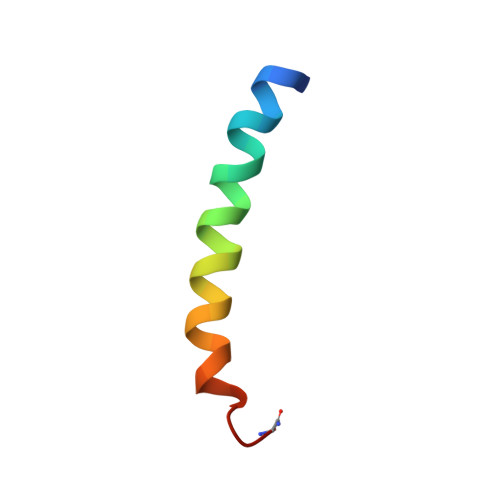Inverse electrostatic effect: electrostatic repulsion in the unfolded state stabilizes a leucine zipper.
Marti, D.N., Bosshard, H.R.(2004) Biochemistry 43: 12436-12447
- PubMed: 15449933
- DOI: https://doi.org/10.1021/bi048771t
- Primary Citation of Related Structures:
1U2U - PubMed Abstract:
The pH-dependent stability of a protein is strongly affected by electrostatic interactions between ionizable residues in the folded as well as unfolded state. Here we characterize the individual contributions of charged Glu and His residues to stability and determine the NMR structure of the designed, heterodimeric leucine zipper AB consisting of an acidic A chain and a basic B chain. Thermodynamic parameters are compared with those of the homologous leucine zipper AB(SS) in which the A and B chains are disulfide-linked. NMR structures of AB based on (1)H NMR data collected at 600 MHz converge, and formation of the same six interchain salt bridges found previously in disulfide-linked AB(SS) [Marti, D. N., and Bosshard, H. R. (2003) J. Mol. Biol. 330, 621-637] is indicated. While the structures of AB and AB(SS) are very similar, their pH-dependent relative stabilities are strikingly different. The stability of AB peaks at pH approximately 4.5 and is higher at pH 8 than at pH 2. In contrast, AB(SS) is most stable at acidic pH where no interhelical salt bridges are formed. The different energetic contributions of charged Glu and His residues to stability of the two coiled coil structures were evaluated from pK(a) shifts induced by folding. The six charged Glu residues involved in salt bridges stabilize leucine zipper AB by 4.5 kJ/mol yet destabilize disulfide-linked AB(SS) by -1.1 kJ/mol. Two non-ion-paired Glu charges destabilize AB by only -1.8 kJ/mol but AB(SS) by -5.6 kJ/mol. The higher relative stability of AB at neutral pH is not caused by more favorable electrostatic interactions in the folded leucine zipper. It is due mainly to unfavorable electrostatic interactions in the unfolded A and B chains and may therefore be called an inverse electrostatic effect. This study illustrates the importance of residual interactions in the unfolded state and how the energetics of the unfolded state affect the stability of the folded protein.
- Institute of Biochemistry, University of Zürich, Winterthurerstrasse 190, CH-8057 Zürich, Switzerland. dmarti@access.unizh.ch
Organizational Affiliation:

















